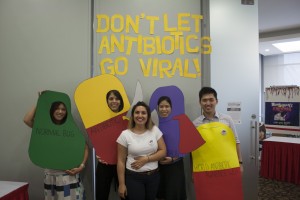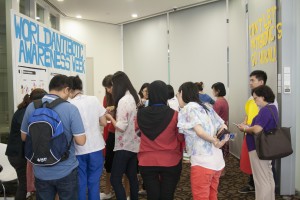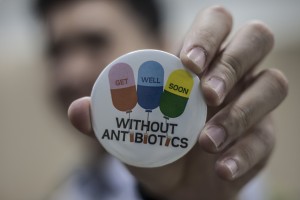When we first decided to join the World Antibiotic Awareness Week (WAAW) launched by the WHO, there were exactly 3 weeks left to prepare. On our list were a journal club, a movie screening, a seminar session, an online quiz, posters, badges, blog posts, three bug costumes, one pill costume, helium balloons and a booth. Whoever thinks three weeks are not enough to organize all of this has clearly never met the Singapore SLING group.
Our specific goals were to i) gather information on the public’s current perceptions of antimicrobial resistance and ii) raise awareness about the over- and misuse of antibiotics as the cause of spreading antibiotic resistance. We brainstormed and discussed, researched and organized, ventured into handicraft and tailored our WAAW gadgets to our expected public, i.e. staff from our own institution, the Saw Swee Hock School of Public Health, as well as doctors, nurses and students from the National University Hospital and National University Health System. Three weeks and several meetings later, we had ticked most things off the list and were ready to take up the challenge: on Monday, November 16th, our booth was all set up and ready for the first WAAW to begin.
So there we were, dressed as gigantic antibiotic pills in the middle of an empty foyer, rain pouring down on our posters and no visitors far and wide. It was only human for us to wonder whether this was all worth it. Luckily, if you passed by our booth later that same week, you know that this was not the end of the story. Bit by bit, people started peeking, reading and approaching us with questions. The interest in our booth spread faster than antibiotic resistance and, within a few sessions, hundreds of people had pleased us with their presence.
Without question, our online quiz about antibiotic resistance was the highlight of our week. Almost invariably, everyone who attempted the quiz started off playfully but ended up taking it very seriously. It was highly rewarding to see people reflect, look up information and dive into intense discussions.
Although a quiz is not equivalent to a scientific study, a few conclusions can be drawn from this simple exercise. Overall, we detected a satisfying level of awareness among our visitors. The perception of antibiotic resistance as an imminent threat to human health seemed to be widespread and most questions were answered correctly by ≥50% of respondents. Nonetheless, the quiz also revealed a few notable knowledge gaps.
For instance, ~29 % of respondents quoted GPs and health clinics as the main source of antibiotic use, while not even half (~46%) of them recognized the food production industry as the largest area of antibiotic overuse (Fig. A). Similarly, a notable ~36% of respondents indicated that “most respiratory infections” can be treated with antibiotics (Fig. B) and another ~36% was not aware that using antibiotics to treat the flu may promote antibiotic resistance (Fig. C).

Digging deeper, a remarkably high proportion of individuals (~54%) seemed to believe that the inappropriate use of antimicrobials will cause the human body itself to become resistant to antibiotics (Fig. D). This seems to be a common misconception that has been found in a number of research studies of public knowledge, attitudes and perceptions surrounding antibiotic resistance, using both quantitative and qualitative research methods 1 2. Whether individuals who do not handle antibiotics daily need a detailed understanding of what “antibiotic resistance” actually means at the molecular level is debatable and whether such inaccurate interpretations of the terminology actually lead to misbehaviour remains to be elucidated3. But if one considers that our respondents sample was heavily skewed towards a medically educated population, it is reasonable to deem these percentages as too high.
Only about half of respondents were aware that hand washing (~55%) or vaccination (~49%) can reduce the spread of antibiotic resistance. The link between such preventive infection control measures and antimicrobial resistance4 did not seem to be intuitive to many of our visitors, suggesting that more education is required.
All in all, at the end of this week we can state with confidence that our booth has, in fact, raised a lot of awareness about antibiotic resistance. Through the quiz, we were able to deliver a good deal of knowledge and awaken curiosity among our visitors. In addition, several people joined us for our journal club, our seminar series and our film screening. That this WAAW was the first step towards broader action in Singapore is not necessarily an overstatement. Because the booth also raised another kind of awareness: we now realize our potential to make a difference in our community and we are determined to make the WAAW an even bigger success next year. And to anyone who might want to join us, we promise it will be highly rewarding.
Nothing left to say but “thank you” to those who stopped by, those who gave us input, those who tried to steal our badges and the brave reader who got to this point. Hoping to see you at our booth next year, we wish you to stay well, hopefully without antibiotics!
- McCullough et al., 2015. A systematic review of the public’s knowledge and beliefs about antibiotic resistance. J Antimicrob Chemother Oct 12. pii: dkv310. [Epub ahead of print]
- Wellcome Trust, 2015. Exploring the consumer perspective on antimicrobial resistance. (accessed: 26.11.2015)
- McNulty et al., 2007. The public’s attitudes to and compliance with antibiotics. J Antimicrob Chemother Aug;60 Suppl 1:i63-8.
- Laxminarayan, R., 2015. Economics of Antibiotic Resistance. Center for Disease Dynamics, Economics and Politics, Latsis Symposium. (accessed: 26.11.2015)



I want to thank you for the superb post!! I surely liked every bit of it. I’ve bookmarked your internet site so I can take a appear at the latest articles you post later on.
Bariatric Commode Chair